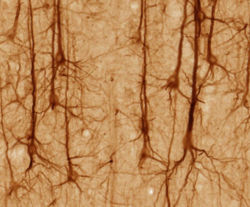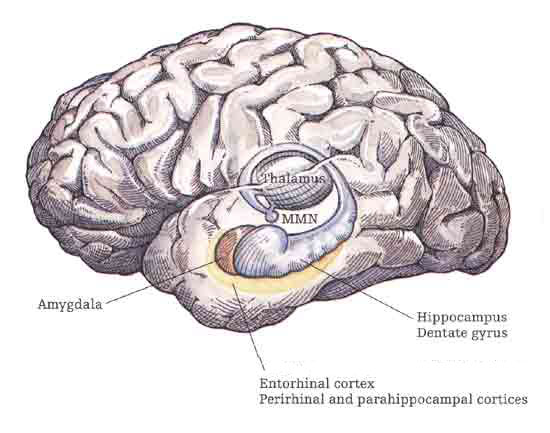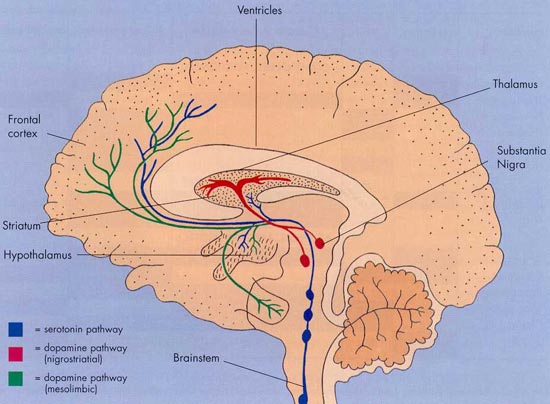Brain facts
The brain weighs three pounds and contain an estimated 100 billion nerve cells. The cerebral cortex, most recently in our evolutionary history, contains about 30 billion neurons and one million billion connections, or synapses. If we counted one synapse per second, we would only be ready after 32 million years. The number of potential neuronal circuits is ten, followed by at least one million zeros. A hyper astronomical amount, given the number of particles in the known universe being 10, followed by 79 zeros.
There is a wide variety of types of neurons, but they all have tree-like branches, called dendrites, which receive synaptic connections. They also have a longer branch, an axon, which makes synaptic connections at the dendrites or at the cell bodies of other neurons. There are probably fifty different types of neurons, but possibly more. An important feature of neural patterns at the microscopic level is their density and distribution. The body of a single neuron is about 50 microns in diameter, which is several thousands of a millimetre. But one axon may be several meters in length. Especially in the cerebral cortex, the neuronal tissue is extremely dense, which also demands an extraordinary blood supply to feed this jungle of cells. The brain is the most metabolically active organ of the body.
The hallmark of neurons from other cells in the body is that they are able to communicate with each other through the synapses mentioned above. The majority of synapses in human brains is chemical. The inside of a neuron is negatively charged relative to the outside. After a cell is stimulated as a result of ion currents like that of sodium and potassium, it becomes less negative. The result is an electrical signal, called an action potential, which moves through the axon to synapses. That allows for the release of neurotransmitters in the pre-synaptic neuron. When the neuron is excitatory, the released neurotransmitters pass the cleft, after which they bind to specific receptors on the postsynaptic neuron, which then becomes less negative. This process takes place in a time period of hundreds to tenths of milliseconds. If the postsynaptic neuron becomes sufficiently less negative after several such events, it will fire, generating an action potential itself. Inhibitory neurons work in a similar way, but they change the electrical charge of the postsynaptic neuron in order to prevent it firing. This electrical signalling leads to changes in biochemistry and even the expression of genes in the target neuron.
In addition to these micro-anatomical characteristics of the brain at higher levels we find important organizational principles of which the following three are essential for their overall performance.
The principle player is the thalamo-cortical system, which consists of separate but highly integrated networks. Theb thalamus, seated In the middle of the brain, receives information from the senses and the rest of the body and is reciprocally connected to the cerebral cortex at the surface of the brain. This cortex has six layers, each with a specific set of inputs and outputs. The cortex and thalamus are subdivided into many areas, each with different functions. This functional separation can be seen at many different spatial scales. Thus the back of the thalamo-cortical system is roughly devoted to perception, while the front is dedicated to action and planning. Most of these cortical areas are grouped as maps: related neurons from one area are connected to neighbouring nerve cells in the other. The integration is striking: most of these groups of neurons are interconnected in a reciprocal pattern. Neurons within the same group at a particular location are closely connected, so many of them respond simultaneously when the appropriate stimulus is presented. Paths from one area to another are called projections.
Neuronal groups that respond to near positions in the visual field are more connected than those responding to more distant positions. In other words, the various separate, functional areas are mutually connected which makes integration of distributed brain functions possible. They provide the main basis for reentry, a process of signalling along reciprocal connections between functionally segregated areas, which thus can be integrated with each other despite the absence of a central coordinator.
In summary:
The organization of the thalamo-cortical network is extremely suitable for integrating large amounts of specialists in a unified response. The thalamo-cortical system is considered as an important contributor to the content of consciousness and forms the basis for my model of the selfreferenced unified informational field (SUIF) that I consider as a conceptual bridge between the neural correlates of consciousness (NCC) and phenomenological (first person) awareness.The second topological arrangement is organized as a series of parallel unidirectional pathways, which connect the cortex with some 'appendages', each with a special structure: the cerebellum, the basal ganglia and hippocampus.
The cerebellum regulates coordination and synchronicity of movement, but also plays a role in thought and language.
The basal ganglia are a large number of nuclei deep in the brain that receive many connections from a large part of the cortex, which then via a number of synaptic steps project to the thalamus and thence back to the cortex. The function is to plan and execute complex motor acts. In neurological diseases like Parkinson's and Huntington's it is these areas that are dysfunctional.The hippocampus is a structure, extended along the lower part of the inside of the temporal cortex, at which input from many cortical areas is funnelled. These synaptic inputs are processed in a number of steps and returned to the same cortical areas. The hippocampus plays a role in consolidating short-term memories into long-term memory locations in the cerebral cortex. Also plays a role in orientation in time and space.
The way these Appendices are organized is the same: long parallel paths with multiple synapses leave the cerebral cortex and reach the successive synaptic stations in the appendices and project back, whether or not via the thalamus, to the cortex. This serial, polysynaptic architecture is fundamentally different from that of the thalamo-cortical system: connections are not reciprocal but form long loops and there are relatively few horizontal interactions between the circuits (except those serving reciprocal inhibition)
A third system consists of clusters or chains, but is a diffuse set of connections that resembles a big fan. The origin of the fan is a relatively small number of neurons in specific nuclei in the brainstem and the hypothalamus. They release specific substances (neuromodulators) such as norepinephrine, serotonin, dopamine, acetylcholine and histamine. Each of these nuclei project diffusely to many parts of the brain and fire when something important happens, such a loud noise, a flash or sudden pain. They affect not only the overall excitability of other neurons but also the plasticity of their compounds as they can change the strength of synapses, serving their adaptive function.
Edelman speaks of value systems. These also play a role in many neurological and psychiatric dysfunctions. Small changes can have large effects on mental functions.
main source: G. Edelman - Consciousness


